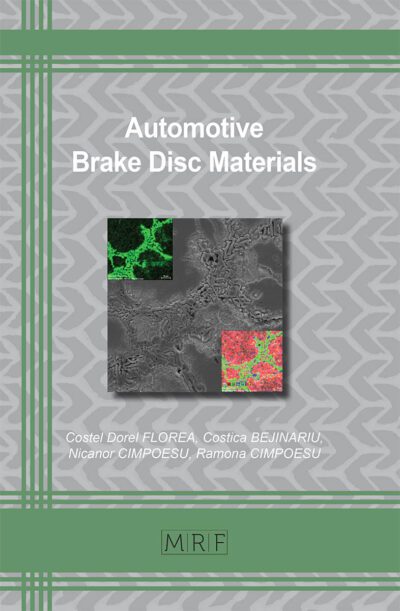Corrosion of the S235JR Carbon Steel after Normalizing and Overheating Annealing in 2.5% Sulphuric Acid at Room Temperature
LIPIŃSKI Tomasz and PIETRASZEK Jacek
download PDFAbstract. The low-carbon steels offer economical properties of mean hardness, strength, and low corrosion resistance, but the steel can be welded without restrictions, usually. The structural low carbon steels have a ferritic-perlitic microstructure. The microstructure depends on the manufacturing technology and heat treatments of steel. This steel is not intended for heat treatment. However, due to the technological process, which is welding, the material often overheats. This overheating causes microstructure growth. The effect of larger grains of the steel microstructure is the reduction of its functional properties. Corrosion resistance is an essential factor in structural steel’s quality and application. The purpose of this article is to investigate corrosion resistance using weight loss and profile roughness parameters of typical structural steel in grade S235JR in 2.5% sulphuric acid solution in distilled water. Samples were tested after normalizing and superheating annealing. Corrosion tests show that continued corrosion characterizes tested steel in both corrosive environments. Roughness parameters for every one of the research times determine the size of steel corrosion.
Keywords
Steel, Structural Steel, Carbon Steel, Corrosion, Corrosion Rate, Profile Roughness
Published online 7/20/2022, 7 pages
Copyright © 2022 by the author(s)
Published under license by Materials Research Forum LLC., Millersville PA, USA
Citation: LIPIŃSKI Tomasz and PIETRASZEK Jacek, Corrosion of the S235JR Carbon Steel after Normalizing and Overheating Annealing in 2.5% Sulphuric Acid at Room Temperature, Materials Research Proceedings, Vol. 24, pp 102-108, 2022
DOI: https://doi.org/10.21741/9781644902059-16
The article was published as article 16 of the book Terotechnology XII
![]() Content from this work may be used under the terms of the Creative Commons Attribution 3.0 licence. Any further distribution of this work must maintain attribution to the author(s) and the title of the work, journal citation and DOI.
Content from this work may be used under the terms of the Creative Commons Attribution 3.0 licence. Any further distribution of this work must maintain attribution to the author(s) and the title of the work, journal citation and DOI.
References
[1] L.L. Machuca, R. Jeffrey, R.E. Melchers. Microorganisms associated with corrosion of structural steel in diverse atmospheres, Int. Biodeterior. Biodegradation 114 (2016) 234-243. http://dx.doi.org/10.1016/j.ibiod.2016.06.015
[2] T. Lipiński. Investigation of corrosion rate of X55CrMo14 stainless steel at 65% nitrate acid at 348 K. Production Engineering Archives 27 (2021) 108-111. https://doi.org/10.30657/pea.2021.27.13
[3] K. Knop. The use of quality tools to reduce surface defects of painted steel structures. Manufacturing Technology 21 (2021) 805-817. https://doi.org/10.21062/mft.2021.088
[4] Uhlig H.H., Revie R.W. Corrosion and corrosion control 3rd Ed. John Wiley and Sons, 1985.
[5] Z. Blikharskyy, J. Selejdak, Y. Blikharskyy, R. Khmil. Corrosion of reinforce bars in RC constructions, System Safety: Human-Technical Facility-Environment 1 (2019) 277-283. https://doi.org/10.2478/czoto-2019-0036
[6] M.A. Azam, N.E. Safie, H.H. Hamdan. Effect of sulfur content in the crude oil to the corrosion behavior of internal surface of API 5L X65 petroleum pipeline steel, Manufacturing Technology 21 (2021) 561-574. https://doi.org/10.21062/mft.2021.066
[7] T. Lipiński. Corrosion effect of 20% NaCl solution on basic carbon structural S235JR steel, Engineering for Rural Development 16 (2017) 1069-1074. https://doi.org/10.22616/ERDev2017.16.N225
[8] E. Naveen, B.V. Ramnath, C. Elanchezhian, M.S.S. Nazirudeen. Influence of organic corrosion inhibitors on pickling corrosion behaviour of sinter-forged C45 steel and 2% Cu alloyed C45 steel. Journal of Alloys and Compounds 695 (2017) 3299-3309. https://doi.org/10.1016/j.jallcom.2016.11.133
[9] N.G. Thompson, M. Yunovich, D. Dunmire. Cost of corrosion and corrosion maintenance strategies, Corros. Rev. 25 (2007) 247-261. https://doi.org/10.1515/CORRREV.2007.25.3-4.247
[10] D. Bricín, A. Kříž. Influence of the Boriding Process on the Properties and the Structure of the Steel S265 and the Steel X6CrNiTi18-10, Manufacturing Technology 21(1) (2021) 37-44. https://doi.org/10.21062/mft.2021.003
[11] P. Szabracki. Effect of aging on the microstructure and the intergranular corrosion resistance of X2CrNiMoN25-7-4 duplex stainless steel, Solid State Phenom. 203-204 (2013) 59-62. https://doi.org/10.4028/www.scientific.net/SSP.203-204.59
[12] E. Skrzypczak-Pietraszek, A. Urbańska, P. Żmudzki, J. Pietraszek. Elicitation with methyl jasmonate combined with cultivation in the Plantform™ temporary immersion bioreactor highly increases the accumulation of selected centellosides and phenolics in Centella asiatica (L.) Urban shoot culture, Engineering in Life Sciences 19 (2019) 931-943. https://doi.org/10.1002/elsc.201900051
[13] M. Dobrzański. The influence of water price and the number of residents on the economic efficiency of water recovery from grey water, Technical Transactions 118 (2021) art. e2021001. https://doi.org/10.37705/TechTrans/e2021001
[14] K. Wójcicka. The efficiency of municipal sewage treatment plants inspiration for water recovery. Technical Transactions 118 (2021) art. e2021023. https://doi.org/10.37705/TechTrans/e2021023
[15] G. Majewski, Ł.J. Orman, M. Telejko, N. Radek, J. Pietraszek, A. Dudek. Assessment of thermal comfort in the intelligent buildings in view of providing high quality indoor environment. Energies 13 (2020) art. 1973. https://doi.org/10.3390/en13081973
[16] A. Sikora. Rzeszów as an example of a ‘new town’ tailored for the modern era. Technical Transactions 118 (2021) art. e2021006. https://doi.org/10.37705/TechTrans/e2021006
[17] S. Marković, D. Arsić, R.R. Nikolić, V. Lazić, B. Hadzima, V.P. Milovanović, R. Dwornicka, R. Ulewicz, R. Exploitation characteristics of teeth flanks of gears regenerated by three hard-facing procedures, Materials 14 (2021) art. 4203. https://doi.org/10.3390/ma14154203
[18] A. Pacana, R. Ulewicz. Analysis of causes and effects of implementation of the quality management system compliant with iso 9001, Polish Journal of Management Studies 21 (2020) 283-296. https://doi.org/10.17512/pjms.2020.21.1.21
[19] R. Ulewicz, F. Novy, R. Dwornicka. Quality and work safety in metal foundry, METAL 2020 – 29th Int. Conf. Metall. Mater. (2020), Ostrava, Tanger 1287-1293. https://doi.org/10.37904/metal.2020.3649
[20] J. Pietraszek, N. Radek, A.V. Goroshko. Challenges for the DOE methodology related to the introduction of Industry 4.0, Production Engineering Archives 26 (2020) 190-194. https://doi.org/10.30657/pea.2020.26.33
[21] PN EN ISO 3651-1, Determination of resistance to intergranular corrosion of stainless steels. Part 1: Austenitic and ferritic-austenitic (duplex) stainless steels. Corrosion test in nitric acid medium by measurement of loss in mass (Huey test).
“”
































